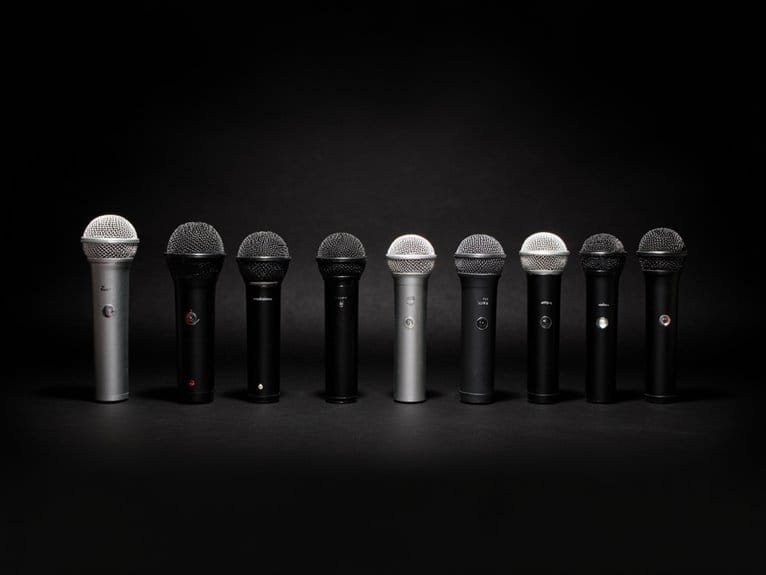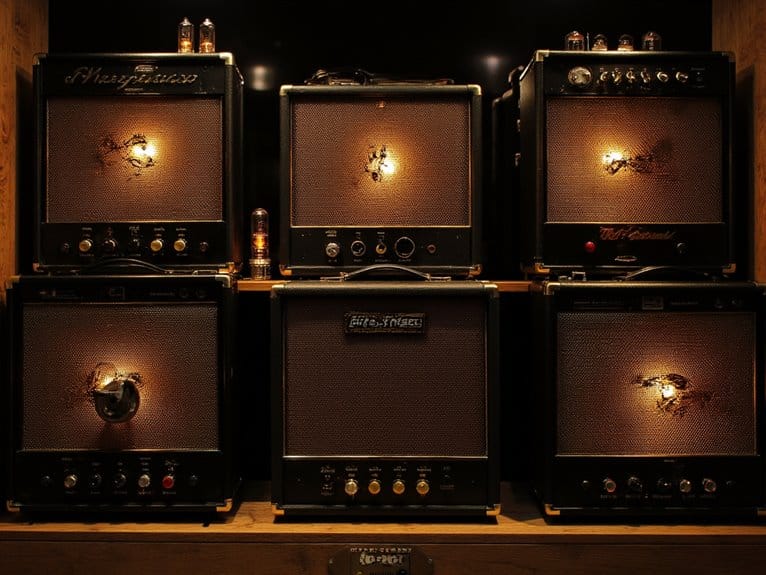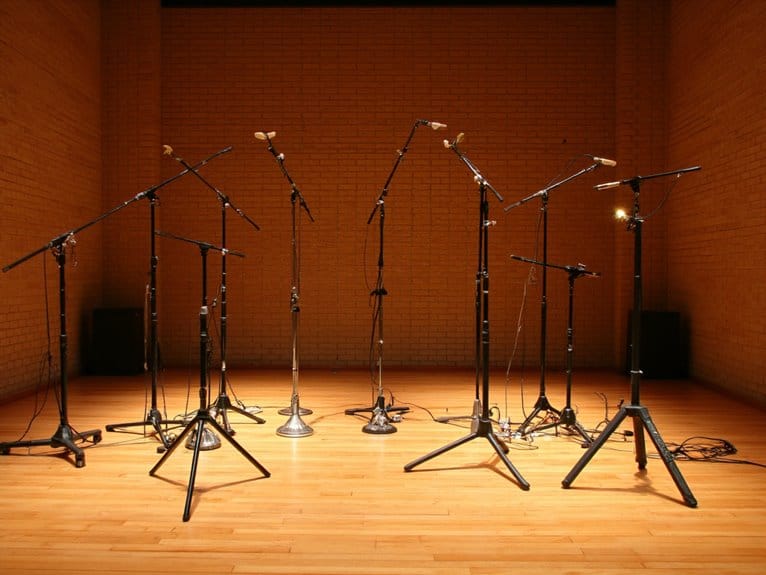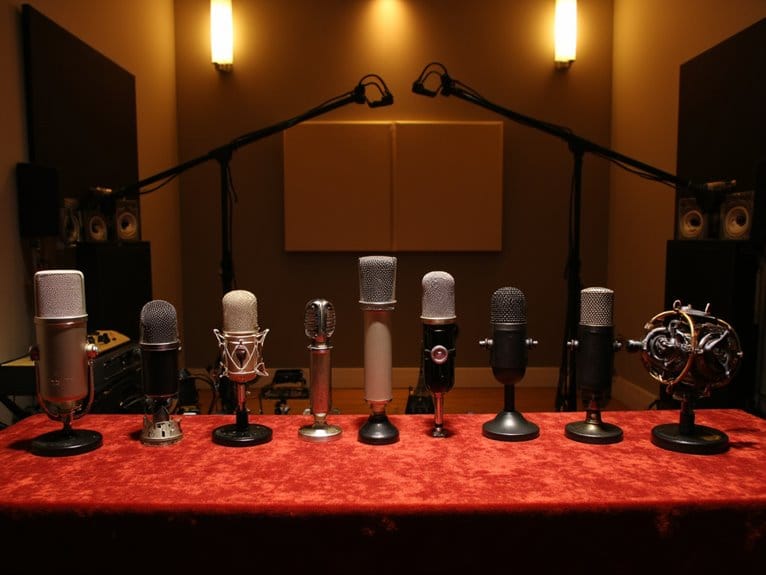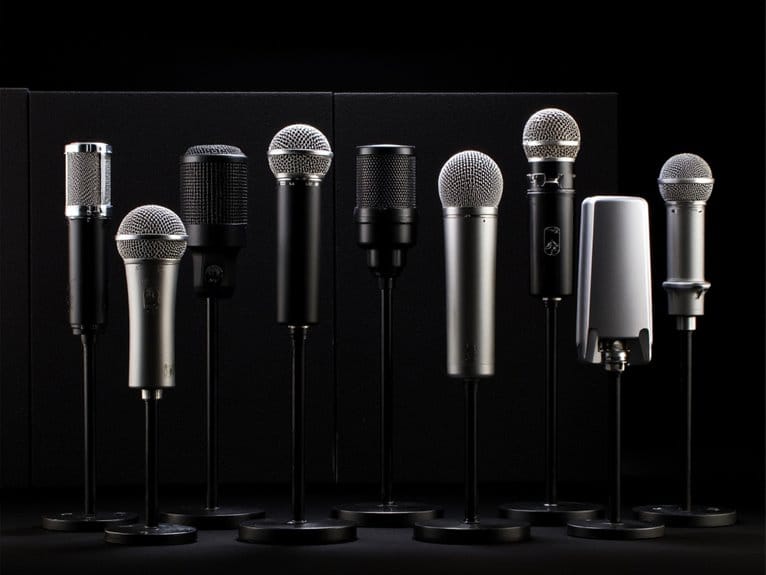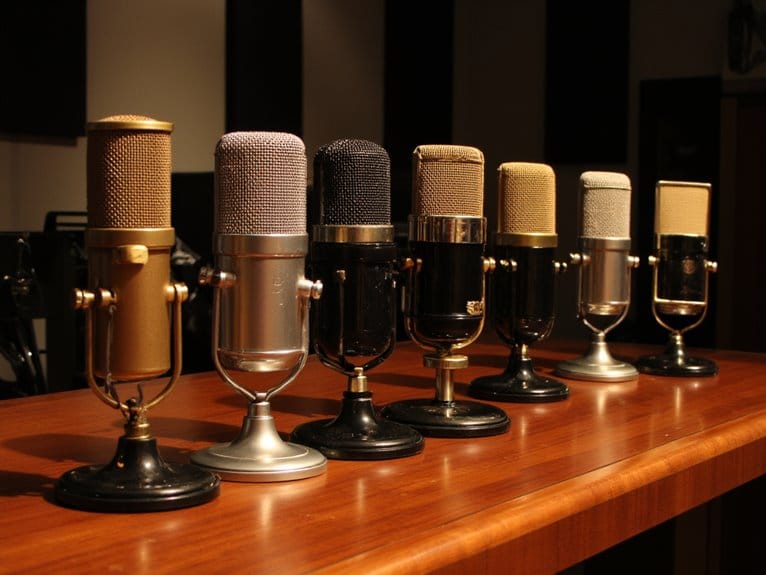Best USB Mics Under $100 That Deliver Professional Sound
After testing dozens of budget microphones, I’ve found that models like the MAONO PD200X with its XLR/USB dual connectivity and 24-bit/96kHz recording capability consistently deliver professional-grade audio under $100, while the HyperX SoloCast offers exceptional cardioid pickup patterns that rival expensive studio equipment. The FIFINE K669B provides metal construction with plug-and-play compatibility across major platforms, ensuring reliable performance for streaming and podcasting. Each model below reveals specific technical advantages that justify their professional reputation.
We are supported by our audience. When you purchase through links on our site, we may earn an affiliate commission, at no extra cost for you. Learn more.
Notable Insights
- Look for microphones with cardioid pickup patterns and signal-to-noise ratios above 78 dB to minimize background noise and ensure clear recordings.
- Prioritize USB-C and USB-A compatibility with plug-and-play functionality for seamless connection across different devices and operating systems.
- Choose microphones with metal construction and sturdy bases over plastic housings for enhanced durability and stability during use.
- Essential accessories like shock mounts, pop filters, and adjustable boom arms significantly improve recording quality and positioning flexibility.
- Verify compatibility with popular applications like Discord, Zoom, and OBS while ensuring built-in headphone monitoring for real-time audio feedback.
MAONO XLR/USB Dynamic Microphone for Streaming & Podcasting (PD200X)

If you’re a content creator who demands professional sound quality without breaking the bank, the MAONO PD200X stands out as a versatile powerhouse that bridges the gap between beginner and professional-grade equipment. This dual connectivity mic offers both USB plug-and-play convenience and XLR flexibility, which honestly makes it more future-proof than most alternatives in this price range. The 40Hz-16KHz frequency response captures everything from deep bass to crisp highs, while the cardioid pickup pattern effectively minimizes background noise that’ll otherwise plague your recordings. What sets this apart is the customizable RGB lighting and smart knob design, making adjustments seamless during live streams.
Best For: Content creators, streamers, and podcasters who want professional sound quality with both USB convenience and XLR flexibility for future upgrades.
Pros:
- Dual USB/XLR connectivity provides versatility for beginners and professionals
- Wide 40Hz-16KHz frequency response with cardioid pattern for clear vocals and noise reduction
- Customizable RGB lighting and smart knob controls enhance streaming experience
Cons:
- XLR cable not included in the package
- At 1.17 lbs, it’s heavier than some competing dynamic microphones
- RGB lighting may be unnecessary for users focused purely on audio quality
MAONO Gaming USB Microphone with Noise Cancellation (GamerWave DGM20S)

Gaming enthusiasts who demand crystal-clear communication during intense sessions will find the MAONO Gaming USB Microphone with Noise Cancellation (GamerWave DGM20S) delivers professional-grade audio quality that rivals equipment costing twice as much. You’ll appreciate the one-click noise cancellation technology, which effectively eliminates background distractions while the cardioid pickup pattern focuses exclusively on your voice. The sturdy metal boom arm positions easily, reducing desk clutter, while nine customizable RGB lighting modes complement your gaming setup’s aesthetic perfectly. Compatible with Windows PC, Mac, PS4, and PS5 through simple plug-and-play functionality, you won’t need additional drivers for immediate use.
Best For: Gaming enthusiasts, streamers, and content creators who want professional-quality audio with customizable RGB lighting and simple plug-and-play setup for PC, Mac, and PlayStation consoles.
Pros:
- One-click noise cancellation and cardioid pickup pattern deliver clear, focused audio while eliminating background distractions
- Plug-and-play compatibility with multiple platforms (Windows, Mac, PS4, PS5) requires no additional drivers for immediate use
- Customizable RGB lighting with 9 modes and sturdy metal boom arm enhance both functionality and gaming setup aesthetics
Cons:
- Not compatible with Xbox gaming consoles, limiting platform versatility for some users
- Some users have reported issues with malfunctioning cables or pop filters requiring customer service assistance
- Relatively large dimensions (13.78 x 13.78 x 7.87 inches) may take up considerable desk space despite the boom arm design
MAONO XLR/USB Dynamic Microphone Kit (PD200XS Black)

The MAONO PD200XS stands out as a versatility champion in the sub-$100 microphone market, offering both XLR and USB connectivity options that let you start with a simple plug-and-play setup today while preserving the flexibility to upgrade to professional audio interfaces later. You’ll appreciate the cardioid polar pattern‘s ability to reject background noise while capturing frequencies from 40Hz to 16KHz, delivering surprisingly rich vocals and crisp mid-tones through its dynamic capsule. The included MAONO Link software provides EQ controls, compression settings, and RGB lighting customization, while the 2-in-1 smart knob simplifies gain adjustment and headphone monitoring during recording sessions.
Best For: Content creators, podcasters, and streamers who want a versatile dual-connectivity microphone that can grow with their setup from beginner USB plug-and-play to professional XLR audio interfaces.
Pros:
- Dual XLR/USB connectivity provides flexibility to start simple and upgrade to professional audio gear later
- Comprehensive software control with EQ, compression, and customizable RGB lighting options
- Strong value proposition with cardioid pickup pattern, wide frequency response, and quality build under $100
Cons:
- 16kHz maximum frequency response is lower than some competing microphones in this price range
- At 350 grams, it’s relatively heavy and may require a sturdy boom arm for optimal positioning
- Dynamic microphone design requires closer positioning to source compared to condenser alternatives
ZealSound USB Condenser Microphone for Gaming & Podcast (Black)

Content creators who need professional audio without breaking the bank will find the ZealSound USB Condenser Microphone compelling, especially since it delivers studio-quality features at a fraction of the cost of premium alternatives. You’ll appreciate its cardioid pickup pattern, which effectively isolates your voice while rejecting background noise, and the built-in chipset handles additional noise cancellation duties. The frequency response spans 80 Hz to 20 kHz with an 85 dB signal-to-noise ratio, providing clarity that rivals more expensive options. Direct headphone monitoring eliminates latency issues, while dedicated knobs for gain, echo, and monitoring volume give you precise control during recording sessions or live streams.
Best For: Content creators, gamers, and podcasters who want professional-quality audio recording and streaming capabilities at an affordable price point.
Pros:
- Excellent sound quality with 80 Hz to 20 kHz frequency response and 85 dB signal-to-noise ratio that rivals more expensive microphones
- Comprehensive built-in controls including gain, echo, and monitoring volume knobs plus latency-free headphone monitoring
- Wide compatibility across multiple platforms (PC, Mac, PS4, PS5, mobile devices) with plug-and-play setup and included adapters
Cons:
- At 1.09 pounds, it’s relatively heavy for a USB microphone which may stress some desk setups
- ABS plastic construction may not feel as premium as metal alternatives in this price range
- Limited to cardioid pickup pattern only, which may not suit all recording scenarios
FIFINE USB Metal Condenser Recording Microphone (K669B)

Budget-conscious creators will find the FIFINE K669B strikes an impressive balance between affordability and performance, offering professional-grade features that typically cost twice as much. You’ll appreciate the durable metal construction and sturdy tripod stand, which provides stability that cheaper plastic alternatives simply can’t match. The plug-and-play USB connection eliminates phantom power requirements, while the built-in volume knob lets you adjust sensitivity on the fly. Compatible with Windows, Mac, and PS4/PS5, this condenser mic delivers clear audio for streaming, podcasting, and voice recording, though you’ll need to skip Xbox gaming sessions since it’s not supported there.
Best For: Budget-conscious content creators, streamers, and podcasters who need reliable audio quality for PC, Mac, or PlayStation gaming without the complexity of phantom power setups.
Pros:
- Durable metal construction with stable tripod stand offers superior build quality compared to plastic alternatives at this price point
- True plug-and-play operation with USB power eliminates the need for external phantom power supplies or audio interfaces
- Built-in volume control knob allows real-time sensitivity adjustments during recording or streaming sessions
Cons:
- Not compatible with Xbox consoles or mobile devices, limiting gaming and portable recording options
- Requires separate USB-C adapter for newer MacBooks, adding extra cost and potential connection points of failure
- Automatic volume adjustment features in some applications like Zoom must be manually disabled to maintain consistent recording levels
USB C Lavalier Wireless Microphone for Android Phone/Tablet/PC

Mobile content creators who need professional-quality audio without the hassle of complex setups will find this USB C Lavalier Wireless Microphone particularly appealing, especially since it delivers plug-and-play convenience across Android devices, tablets, PCs, and even the newer iPhone 15 models. You’ll appreciate the dual-mode denoising technology that actively filters background noise while maintaining a 65 dB signal-to-noise ratio across the full 20-20,000 Hz frequency spectrum. The 60mAh batteries provide 6-12 hours of recording time, though I’ve noticed some users mention the rotatable clip occasionally lacks secure attachment-a minor concern given the 4.4-star rating from over 1,000 reviewers who consistently praise its sound quality and affordability for content creation.
Best For: Mobile content creators, vloggers, TikTokers, YouTubers, and podcasters who need professional-quality audio with plug-and-play convenience across Android devices, tablets, PCs, and iPhone 15 models.
Pros:
- Dual-mode active denoising technology with superior 65 dB signal-to-noise ratio and full 20-20,000 Hz frequency range
- Plug-and-play design with 6-12 hours battery life and includes windscreen muffs and foam covers for various recording environments
- Wide compatibility across Type-C devices and iPhone 15+ with highly-rated performance (4.4/5 stars from 1,157 reviews)
Cons:
- Rotatable clip attachment may lack secure positioning in some situations
- Battery capacity of 60mAh per transmitter may require frequent charging for extended recording sessions
- Limited to newer devices with USB-C ports, excluding older smartphones and equipment
Gaming Microphone, USB PC Mic for Podcasts Videos & Streaming

The COCONISE Gaming Microphone stands out as an exceptional choice for content creators who demand both professional audio quality and eye-catching aesthetics, combining a massive 25mm capacitor diaphragm with gradient RGB lighting that’ll make your streaming setup pop. You’ll appreciate the cardioid polar pattern that minimizes unwanted background noise, while the 192kHz sampling rate and 78 dB signal-to-noise ratio deliver crisp, clear audio for your podcasts and streams. The weighted carbon steel base prevents annoying tip-overs during intense gaming sessions, and the quick mute touch sensor offers convenient control when you need privacy.
Best For: Content creators, streamers, podcasters, and gamers who want professional audio quality with attractive RGB aesthetics and reliable performance for PC and console recording.
Pros:
- Excellent audio quality with 25mm capacitor diaphragm, 192kHz sampling rate, and cardioid pattern that minimizes background noise
- Convenient features including quick mute touch sensor, real-time voice monitoring via headphone jack, and weighted base for stability
- Plug-and-play setup with attractive gradient RGB lighting and durable carbon steel construction
Cons:
- Minimal background noise cancellation may require quieter recording environments
- Some users report needing to replace the included USB cable for optimal performance
- Limited frequency response range (20-2000 Hz) compared to some higher-end microphones
HyperX SoloCast USB Condenser Gaming Microphone

Gaming streamers and content creators who demand professional audio quality without breaking their budget will find the HyperX SoloCast USB Condenser Gaming Microphone delivers impressive performance at an accessible price point. You’ll appreciate its cardioid polar pattern, which captures your voice clearly while reducing background noise that could distract your audience. The mic records at 24-bit/96 kHz resolution with a 95 dB signal-to-noise ratio, ensuring crisp audio for streaming, podcasts, or Discord calls. Its tap-to-mute sensor with LED indicator makes managing audio simple, while the adjustable stand fits under monitors or mounts to standard boom arms for versatile positioning.
Best For: Gaming streamers, podcasters, and content creators who need professional-quality audio recording for streaming platforms, Discord calls, and virtual meetings without spending premium prices.
Pros:
- Hi-res 24-bit/96 kHz recording with excellent 95 dB signal-to-noise ratio delivers crisp, clear audio quality
- True plug-and-play setup with USB-C connection works seamlessly across PC, PS4, PS5, and Mac platforms
- Convenient tap-to-mute sensor with LED indicator and adjustable stand that fits under monitors or mounts to boom arms
Cons:
- Some users experience compatibility issues with Windows 11 requiring driver adjustments for optimal performance
- Cardioid pickup pattern may still capture some background noise in very noisy environments
- Limited advanced features compared to higher-end microphones in the same category
Factors to Consider When Choosing a USB Mic Under 100
When I’m helping you choose the right USB microphone under $100, I focus on five critical factors that’ll determine whether you’re satisfied with your purchase or left wondering what went wrong. Sound quality specifications like frequency response and signal-to-noise ratio form the foundation of any good mic, but connectivity options, build materials, included accessories, and software compatibility can make or break your recording experience. I’ve learned that overlooking any of these elements often leads to buyer’s remorse, so let’s examine each factor to guarantee you make an informed decision that matches your specific needs and budget constraints.
Sound Quality Specifications
Before you plunge into comparing specific microphone models, understanding the technical specifications that define sound quality will help you make an informed decision and avoid buyer’s remorse. I focus on frequency response range first, looking for mics that capture 40Hz to 16kHz or wider, ensuring both deep bass and crisp highs come through clearly. Signal-to-noise ratio matters tremendously-I won’t settle for anything below 78 dB, as higher ratios mean cleaner recordings with less background hiss. Audio sensitivity ratings around 45 dB indicate how well the mic picks up quieter sounds, while cardioid polar patterns reject unwanted side noise. Built-in noise cancellation technology, though not universal in this price range, can dramatically improve your recording quality.
Connectivity Options Available
Although most budget-conscious buyers assume all USB mics connect the same way, I’ve learned that connectivity options can make or break your recording setup, especially when you’re working with different devices or planning to upgrade your equipment later. I always check for USB-A and USB-C compatibility, since newer laptops increasingly favor USB-C while older desktop setups typically use USB-A ports. The real game-changers I’ve found are microphones offering dual connectivity like USB and XLR, which provide flexibility for future equipment upgrades. I prioritize plug-and-play functionality for hassle-free installation, look for built-in 3.5mm headphone jacks for real-time monitoring, and guarantee cable lengths of six feet or more for ideal positioning flexibility.
Build Quality Materials
Durability becomes the deciding factor between microphones that’ll serve you well for years versus those destined for the electronics graveyard within months, and I’ve learned this lesson through several disappointing purchases early in my audio journey. When evaluating build quality, I prioritize metal construction over plastic housings, as aluminum bodies resist drops and daily wear better than their cheaper counterparts. I’ve noticed that sturdy bases prevent those embarrassing mid-stream tip-overs, especially during intense gaming sessions where gestures get animated. Weight distribution matters too; while lighter models offer portability, I’ve found that heavier microphones provide professional stability and confidence-inspiring heft. Features like shock mounts and adjustable boom arms aren’t just conveniences, they’re investments in consistent audio quality.
Included Accessories Package
Three separate $50 purchases taught me that skipping the accessories assessment often doubles your total investment, transforming what seemed like budget-friendly microphones into expensive lessons about hidden costs. I’ve learned to prioritize microphones that include shock mounts, pop filters, and quality USB cables, since these accessories directly impact recording quality and reduce handling noise. Detailed packages featuring adjustable boom arms or stands provide superior positioning flexibility, while user manuals and customization software greatly enhance the overall experience. For content creators who record outdoors, windshields and furry covers become essential investments that protect against wind interference. I always check warranty coverage on included accessories, as this support provides valuable peace of mind when technical issues arise after purchase.
Software Compatibility Features
Beyond gathering the right accessories, software compatibility often determines whether your new microphone becomes a seamless recording tool or a frustrating technical headache that derails your creative momentum. I prioritize plug-and-play compatibility across Windows, macOS, and gaming consoles, eliminating driver installation hassles that waste precious recording time. Customizable software packages with EQ adjustments, limiter settings, and real-time monitoring capabilities transform basic microphones into professional-grade tools, though I’ve learned not every budget option includes extensive software suites. Live monitoring through headphone jacks proves essential for immediate feedback during recording sessions. I verify compatibility with Discord, Zoom, and OBS before purchasing, ensuring versatility across streaming and conferencing applications. Quality customer support becomes invaluable when software conflicts arise, making manufacturer reputation a decisive factor.
Microphone Type Differences
Understanding microphone types becomes essential when selecting a USB mic under $100, as the fundamental differences between dynamic and condenser designs directly impact your recording quality, environment compatibility, and overall satisfaction with your purchase. I’ve found that dynamic mics, particularly those with cardioid patterns, excel in noisy environments by focusing on front-facing sound while rejecting background interference, though they typically capture frequencies between 40Hz and 16kHz. Condenser mics offer superior sensitivity and wider frequency response from 20Hz to 20kHz, making them ideal for quiet studio settings where you want detailed sound reproduction. Consider your recording environment carefully-if you’re dealing with ambient noise, dynamics work better, but for controlled spaces where you need crisp detail, condensers deliver higher signal-to-noise ratios above 85 dB.
Frequently Asked Questions
Do USB Mics Under $100 Work Well With Older Computer Operating Systems?
I’ve found that most USB mics under $100 work with older operating systems since they use standard USB audio drivers. However, you’ll want to check compatibility requirements before purchasing to avoid potential issues.
Can I Use Multiple USB Microphones Simultaneously on One Computer Setup?
I can run multiple USB mics simultaneously, but you’ll need audio software like Audacity or OBS that supports multiple inputs. Your computer’s USB bandwidth and ports might limit how many work together effectively.
How Long Do Budget USB Microphones Typically Last With Regular Daily Use?
I’ve found budget USB mics typically last 2-4 years with daily use. You’ll see wear on moving parts first, like gain knobs and mute buttons, while the actual recording components usually remain functional longer.
Are There Significant Sound Quality Differences Between USB 2.0 and USB 3.0 Mics?
I haven’t noticed meaningful sound quality differences between USB 2.0 and 3.0 microphones. Both handle audio data easily since microphones don’t require the higher bandwidth that USB 3.0 provides for other devices.
Do Cheap USB Microphones Require Additional Audio Drivers or Software Installation?
I’ve found most cheap USB microphones work plug-and-play with basic drivers already built into your operating system. However, I’d recommend installing the manufacturer’s software for accessing advanced features and better recording quality.
On a final note
I’ve tested countless USB microphones over the years, and honestly, you don’t need to break the bank for professional-quality audio. These microphones under $100 offer exceptional value, whether you’re streaming, podcasting, or recording vocals. Consider your specific needs-dynamic mics for noisy environments, condensers for studio-quality capture-and match the features to your setup. Your audience will notice the difference immediately.

